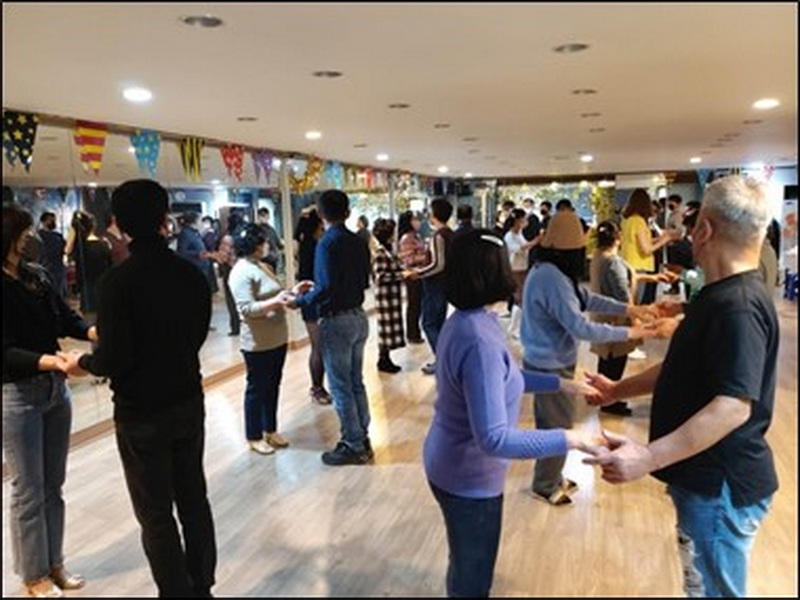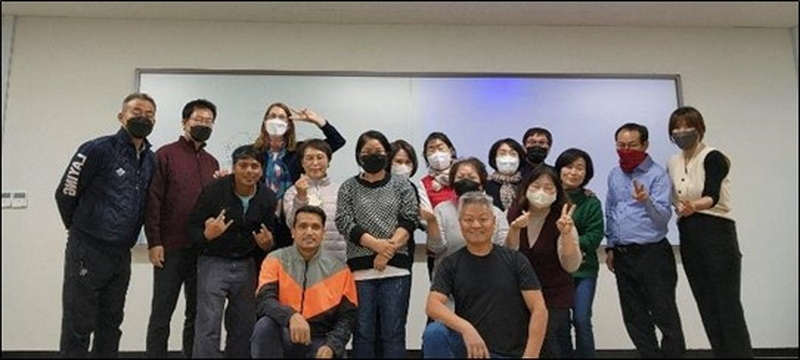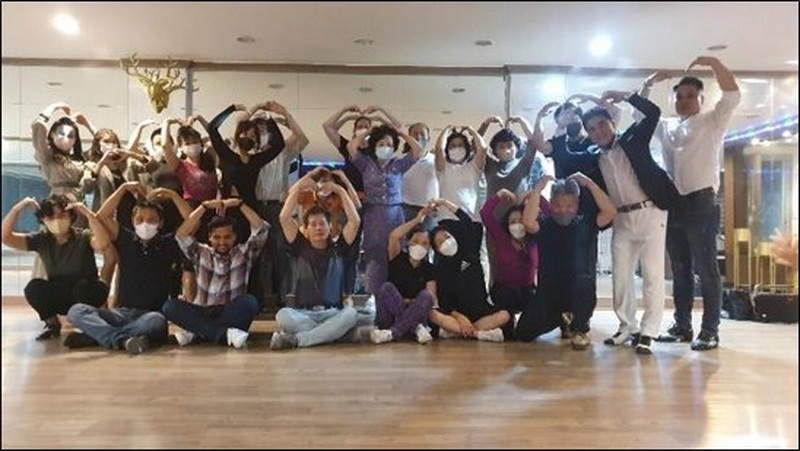Changing Perceptions on Dance: Couple Dance in General and Latin Dance in Particular
By Hong Nam-son and Jocelyn Wright
Singing is really not my thing, and casual group singing was not very typical in the culture I grew up in, so when I first arrived in South Korea, I was really surprised at how many norae-bang (singing rooms) there were. I also found it strange when I heard stories about foreign friends being refused entry into night clubs or college-aged Koreans saying they didn’t go because they were “too old.” Dancing was a more popular and common activity among young (and not so young) adults in Canada. It was also something I enjoyed, even if I could not claim to be very good at it.
Fast-forward almost fifteen years, a Korean friend of mine, Professor Emeritus Hong Nam-son, who has been studying dance in Gwangju for a while now, is trying to establish a Latin dance culture in Mokpo. While many people seem curious about this, there also seems to be some resistance to and stereotypes about couple dance culture. To understand why this is so, and to raise awareness and possibly change perceptions about this social activity, I interviewed him for the Gwangju News.
Jocelyn Wright (JW): Hello and thanks for joining us here, Nam-son! Could you tell us a little about your dance background?
Hong Nam-son (HN): Until I was about forty years old, there was not really a couple dance culture in Korea. Couple dance was regarded as somewhat immoral. The first dancesport class started in my town, Muan, in 2005, but I couldn’t enroll alone. Back then, only married couples were allowed to register. I was only able to start couple dancing late in my life. When I was fifty-five, I began to learn dancesport at the Center for Lifelong Education at Mokpo National University (MNU).

JW: Fascinating! So, you have been dancing for over a decade now, I guess. What can you dance? Did you specialize in one kind of dance or try a few?
HN: Well, since the first class, I have learned many kinds of dances. Dancesport usually consists of five standard and five Latin dances with a competitive element.
JW: Oh, have you competed?
HN: There is a Championship of Dancesport event in Mokpo every July: the Mokpo Beach Cup of Dancesport. Once, I won a silver medal, though it was not very competitive.
JW: I didn’t know that. Congratulations all the same! So, have you studied all 10 dancesport dances?
HN: Thanks! Well, I have learned all five Latin dances (rumba, cha-cha, jive, samba, and pasodoble) as well as three standard dances (waltz, Vienna waltz, and tango). I have studied other kinds of dance, too: swing dance and traditional Korean dance (but this is not danced in pairs). These days, I am focusing on salsa, bachata, and Argentinian tango.
JW: Wow, that’s even more than I realized! Why do you think dancing is important? For me, it’s a holistic activity, since it allows us to engage the body, mind, and soul through physical exercise, social interaction, cultural learning, and artistic expression. How about you?

HN: A well-known psychologist, Abraham Maslow (1908–1970), said that humans have five categories of needs: physiological, safety, social, esteem, and self-actualization. When dancing, I feel all these needs are fulfilled at the same time. My ears listen happily to music. I feel safe in a cozy dance bar. I feel I am accepted by my friends. Many beginner dancers in my club respect me, and I am proud when I can lead a woman to dance gracefully.
JW: That all sounds really wonderful to me! So, why might many people in Korea feel uncomfortable doing couple dance?
HN: In Korean tradition, except for married couples, grownups were not supposed to touch someone of the opposite sex. The tradition is changing slowly. Some friends in my dance club still tell me that they have to conceal their dance life from their spouses, though. This seems to be the main reason why Koreans feel uncomfortable.
JW: So, in your opinion, how can they overcome their discomfort and learn, for example, to appreciate Latin dance?
HN: To do is to get used to. Only if they are exposed to couple dance a little bit, can they understand that dancing is not a big deal. That is why I give free lessons – to encourage people to give it a try.

JW: You are one of the busiest people I know, but you still offer one of the best gifts there is: your time! It’s really kind and generous of you and so amazing for those of us who have experienced your classes! Could you share with readers what you have been doing to establish a Latin dance culture in Mokpo?
HN: In 2020, when you and your husband, Prabesh, asked me to teach you Latin dance, I opened a free dance class in a classroom at MNU. We started with salsa because it is one of the most common dances worldwide, but we also did bachata, which is a little easier. Since then, many residents from the surrounding area have joined us. Now, I’m teaching three different classes a week. I also held two dance parties last year, which were the first salsa dance events ever in Mokpo.

JW: And they were fantastic! The atmosphere was really friendly and supportive each time, never uncomfortable. What was also cool was that a partner from Gwangyang also organized a party with us in between! All of these events were aimed at beginner to low-intermediate dancers, and they started with some lessons, included a meal, and finished with a free dance, which allowed participants to try out their new skills or further develop what they had previously learned. In your view, how important is it to have events to encourage beginners?
HN: Lessons alone can be boring. Beginners may lose interest if there is no stimulation like dance parties. At the same time, they can feel intimidated if everyone else is already much better than they are – this is especially true for men who typically bear more responsibility as the leaders in Latin dance.
JW: Right! Stimulating events and practice opportunities that are within what Lev Vygotsky (1886–1934) called their “zone of proximal development” are so necessary! Now, if anyone is interested, how can they learn more?
HN: In Cheonggye, Muan, there are free Latin dance classes on Thursday afternoons and Friday evenings. I also operate a paid salsa class in Mokpo on Saturday afternoons. Interested readers can feel free to call or text me at 010-3554-2617.

JW: Of course, there seem to be more and more opportunities to learn Latin dance in other nearby cities, with Gwangju maybe being the biggest hub, right?
HN: Yes, it’s possible to learn Latin (and other) dances here and elsewhere in Jeonnam (Suncheon, Gwangyang, Yeosu…), in addition to other major cities in Korea.
JW: I recall hearing about a Cuban dance party recently in Suncheon that sounded really fun and successful! These events are so exciting and maybe motivation to travel around a bit more and meet new people. Well, thank you so much for joining me in this interview and for everything you do for our local communities as a passionate dance teacher and enthusiastic cultural leader!
HN: It was a great honor for me. I have enjoyed talking about dance. I also appreciate that you and Prabesh have been by my side as we work on establishing a Latin dance culture in Mokpo/Muan.
Photos and graphics courtesy of the authors.
The Authors
Professors Hong Nam-son from Korea and Jocelyn Wright from Canada have been good friends for about 13 years. They met at Mokpo National University, where they were colleagues in the Departments of Business Administration and English Language and Literature, respectively, until Nam-son retired a few years ago. Their first mutual interest was tennis, but they later began participating in the same Spanish club (and later teaching Spanish), and started Latin dance together in Mokpo/Muan. However, those are only a few of their common interests!






